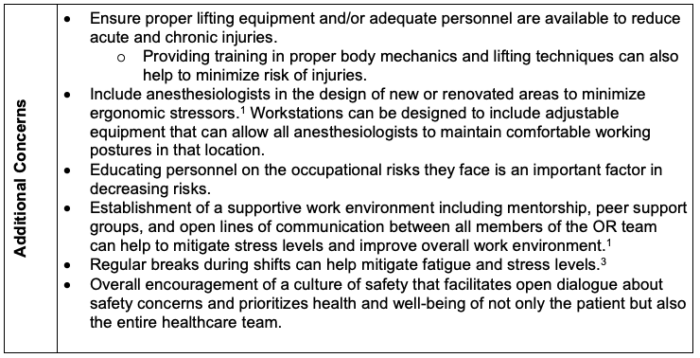Copy link
Occupational Health
Last updated: 04/04/2025
Key Points
- Awareness of occupational hazards can help anesthesiologists avoid exposures and injury.
- Anesthesiologists are frequently exposed to various hazards in anesthetizing locations, which can be physical, chemical, biological, and ergonomic.
- Waste anesthetic gases constitute a significant exposure concern in anesthetizing locations, but modern gas scavenging systems can mitigate this.
- Anesthesiologists must have access to appropriate equipment to decrease the risk of exposure and injury.
Exposures and Hazards
- Occupational exposures and hazards can be categorized into physical hazards, chemical exposures, biological exposures, ergonomic hazards, and psychological impacts (Table 1).

Table 1. Categories and examples of occupational hazards and exposures. Please see the Other Resources section for links to related summaries.

Table 2. Recommended exposure limits for volatile anesthetics (Daily limits in parts per million, unless otherwise noted). Adapted from Varughese et al. Environmental and occupational considerations of anesthesia. Anesth Analg. 2021.5
Abbreviation: NIOSH, National Institute for Occupational Safety and Health
aThe exposure level that cannot be exceeded during a 1-h period.
Mitigation Strategies
- Each category of occupational hazard and exposure has several strategies that should be adopted to maximize prevention and safety.


Table 3. Mitigation strategies for occupational hazards

Figure 1. Infographics on contact, airborne, and droplet precautions. Source: United States Center for Disease Control and Prevention.
References
- Nelson O, Greenwood E, Simpao AF, Matava CT. Refocusing on work-based hazards for the anesthesiologist in a post-pandemic era. BJA Open. 2023; 8:100234. PubMed
- Ayoğlu H, Ayoğlu FN. Occupational risks for anesthesiologists and precautions. Turk J Anaesthesiol Reanim. 2021;49(2):93-99. PubMed
- Volquind D, Bagatini A, Carneiro Monteiro GM, Londero JR, Benvenutti GD. Occupational hazards and diseases related to the practice of anesthesiology. Braz J Anesthesiol. 2013;63(2):227-32. PubMed
- Anesthetic Gases: Guidelines for Workplace Exposures. Occupational Safety and Health Administration. U.S. Department of Labor. July 1999. Updated May 2000. Accessed April 4, 2025. Link
- Varughese, S; Ahmed, R. Environmental and occupational considerations of anesthesia: A narrative review and update. Anesth Analg. 2021:133(4): 826-35. PubMed
Other References
- Occupational Health and Wellness. ASA Committee on Occupational Health Work Products. Accessed April 4, 2025. Link
- Recommendations for Infection Control for the Practice of Anesthesiology: Preventing Infectious Transmission during Anesthesia Care. American Society of Anesthesiologists. 2024. Asahq.org. Membership required. Link
- Infographic for comparison of different sources of commonly encountered radiation exposure. xkcd.com. Accessed April 4, 2025. Link
- Rashid W, Huang J. Distractions in the Operating Room. OpenAnesthesia.org. Published May 24, 2024. Accessed April 4, 2025. Link
- Dascalu I, Heape K. Clinical Alarms and Alarm Fatigue. OpenAnesthesia.org. Published October 2, 2024. Accessed April 4, 2025. Link
- Saksa D, Khan R, Primm A. Provider and Patient Safety in Non-Operating Room Anesthesia Locations. OpenAnesthesia.org. Published December 4, 2024. Accessed April 4, 2025. Link
Copyright Information

This work is licensed under a Creative Commons Attribution-NonCommercial-NoDerivatives 4.0 International License.